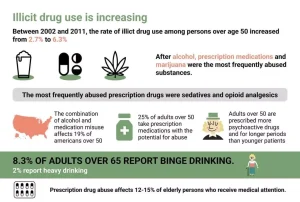
In sum, clinicians should carefully monitor patients receiving long-term therapeutic administration of stimulant medications for signs of adverse effects on development, substance abuse, central toxicity or psychological problems. Research agencies should study effects of protracted exposure in nonhuman primates, and sponsor longitudinal studies of indices of healthy aging in adults exposed to protracted courses of medical amphetamines. Despite information on the effects of stimulants in laboratory animals, profound species differences in susceptibility to stimulant-induced neurotoxicity underscore the need for systematic studies of prolonged human exposure. Early amphetamine treatment has been linked to slowing in height and weight growth in some children. Because the number of prescriptions for amphetamines has increased several-fold over the past decade, an amphetamine-containing formulation is the most commonly prescribed stimulant in North America, and it is noteworthy that amphetamines are also the most abused prescription medications. Although early treatment does not increase risk for substance abuse, few studies have tracked the compliance and usage profiles of individuals who began amphetamine treatment as adults.
Pharmacology of MDMA and related drugs
- These substances require careful consideration and monitoring by medical professionals due to their potential risks and benefits.
- Store it at room temperature and away from light, excess heat and moisture (not in the bathroom).
- Because of this, a person living with addiction is not “weak” or “lacking in willpower.” A person can manage this chronic, progressive health condition with appropriate treatment, just as people can manage many other health conditions.
- A recent review concluded that 20% of adults with substance abuse disorders have ADHD, and that ADHD both alone and in combination with co-occurring psychopathology increases risk for the development of substance abuse disorders in adulthood 92.
- This vogue among teenagers and young adults, together with the widespread belief that “ecstasy” is a safe drug, has led to a thriving illicit traffic in it.
Because they are the primary people dispensing medications, they can watch for falsified prescriptions or drugs that people refill too often. A person living with an addiction may find that they cannot control their use of a particular substance or activity, such as drinking alcohol, smoking, using recreational drugs, or gambling. Reports exist of increased risk of premature delivery and low birth weight in infants born to mothers with amphetamine dependence as amphetamine crosses the placenta.
What should I do if I miss a dose of amphetamine?
If you take amphetamines and feel you are dependent on the drug, talk with your healthcare provider. On the whole, it is relatively mild, resembling a viral hepatitis, with jaundice, an enlarged tender liver, an increased bleeding tendency, raised liver enzyme levels in the blood https://ecosoberhouse.com/ and a biopsy picture of acute hepatitis that is not in any sense diagnostic of MDMA toxicity. Andreu and colleagues103 found that in their hospital “ecstasy” was the second most common cause of liver injury in patients under the age of 25 years. Although there are conflicting theories concerning the mechanism of this neurotoxicity,4,27,63 it is clearly related to the excessive metabolic activity and neurotransmitter release in the serotonergic and, possibly, the dopaminergic neurons. Administration of amphetamines for prolonged periods of time may lead to drug dependence and must be avoided. Assess the risk of abuse prior to prescribing, and monitor for signs of abuse and dependence while on therapy.

Amphetamine abuse: developmental stage influences risk
- A person may seek to repeat the good feeling and come to rely on the substance or activity.
- They can also use the Substance Abuse and Mental Health Services Administration’s Behavioral Health Treatment Services Locator to find local help and treatment.
- According toJohns Hopkins Medicine, the half-life for the popular amphetamine Adderall is 9 hours for the immediate-release version and hours for its extended-release version.
- Food may increase the length of time that it takes for Adderall to reach its maximum concentration in the blood.
Many of the behavioral effects of amphetamines that have been observed in humans can be demonstrated in experimental animals. These include arousal, hyperactivity, stereotypic perseverative movements, psychomotor depression, cognitive impairment, hallucinatory-like behaviors, and chronic self-administration. Evidence indicates that the effects of amphetamine on the neurotransmitters dopamine and norepinephrine play critical roles in eliciting these effects. After chronic exposure to amphetamines, animals exhibit either tolerance (an attenuated response) or sensitization (an augmented response) during subsequent drug administration, indicating that adaptations in the neurobiological substrates of these behaviors. The extended-release suspension is usually taken once daily in the morning with or without food.
- The average amphetamine dosage is 5 to 40 milligrams (mg), one to three times per day, divided at four to six-hour intervals.
- Evidence indicates that the effects of amphetamine on the neurotransmitters dopamine and norepinephrine play critical roles in eliciting these effects.
- Moreover, in the 1950s and 1960s, it was widely prescribed as a medication for depression and obesity 25.

Store the orally disintegrating tablet blister packages in the provided plastic sleeves. Store the extended-release orally disintegrating tablet blister packages in the rigid, plastic travel case after removal from the carton. Store it at room temperature and away from light, excess heat and moisture (not in the bathroom). If you or your child are taking amphetamine for ADHD, your doctor will probably start you on a low dose of amphetamine and increase your dose gradually, every 4 to 7 days, depending on the medication.
- It is notable that the motivation for ingesting these substances was reported as “getting high” in only 22% of ADHD patients, but more often reported as self-medication for tiredness resulting from disturbed sleep (38% of ADHD patients) or self-medication of impaired mood (most ADHD patients).
- Based on the half-life of Adderall, the body eliminates the drug within a few days.
- Nevertheless, it was added to the Schedule I drug list in 1985 and has remained there ever since 26.
- Sedation and lethargy are extremely rare adverse effects that may appear with the administration of psychostimulants, and it has been shown that MAS are no exception 56.
- It should not be used in place of the advice of your physician or other qualified healthcare providers.
- In a multi-site phase 3 clinical trial, Mitchell et al. 62 employed a randomized, double-blind, placebo-controlled approach to investigate the effectiveness and safety of MDMA-assisted therapy for individuals with severe PTSD.
How Long Do Amphetamines Stay in Your System Based on Routes of Exposure?

Phentermine is a sympathomimetic amphetamine stimulant with a methyl substituent on the phenylethylamine side chain, which lowers CNS activation 37. Framprofazone is a component of the multi-ingredient medication Gewodin, which presents antipyretic, analgesic, and sympathomimetic properties. The identification of the 3-hydroxymethylpyrazolone metabolite was determined to be definitive proof of famprofazone administration 36. The basic chemical structure of amphetamine is composed of a phenethylamine backbone with a methyl group attached to the alpha carbon. Substitutions produce related compounds such as methamphetamine and MDMA, among others (Figure 1) 24,30.

It has been used to counteract the effects of benzodiazepines and to increase workload capacity and cardiovascular function 36. Among the many metabolites identified, 1-phenyl-2-(N-methyl-N-valerolactonylamino)propane was discovered to be unique in its properties and application, establishing furfenorex as the source of amphetamine and methamphetamine 36. Fenethylline, a CNS stimulant, is used for the treatment of ADD, narcolepsy, and depression.
Therapeutic Applications

This act mandates a comprehensive behavioral, educational and medical evaluation of children suspected of having an educational disability. A physician visit is not required, but the school district is obligated to provide any diagnostic services that are needed at no cost to parents 12. Tell your doctor if you or anyone in your family drinks or has ever drunk large amounts of alcohol, uses half life of amphetamines or has ever used street drugs, or has overused prescription medications. The largest series of ecstasy-related transplants reviewed so far is described by Brauer and colleagues,116 who found 9 cases in the literature plus one of their own; of these, 4 died after the transplant while 6 survived, having either fully or partially recovered. MDMA and its related compounds are generally produced as racemic mixtures, but the stereoisomers differ from each other in several important respects.
